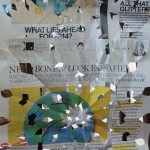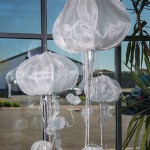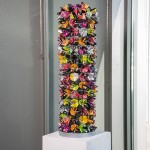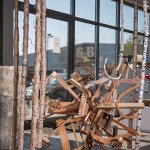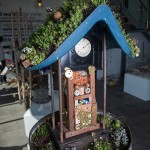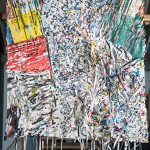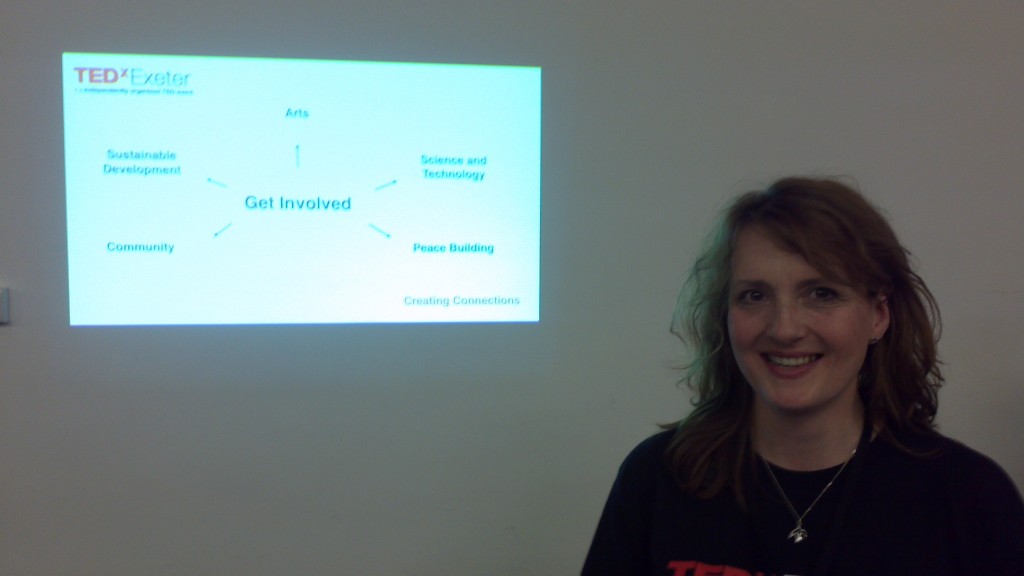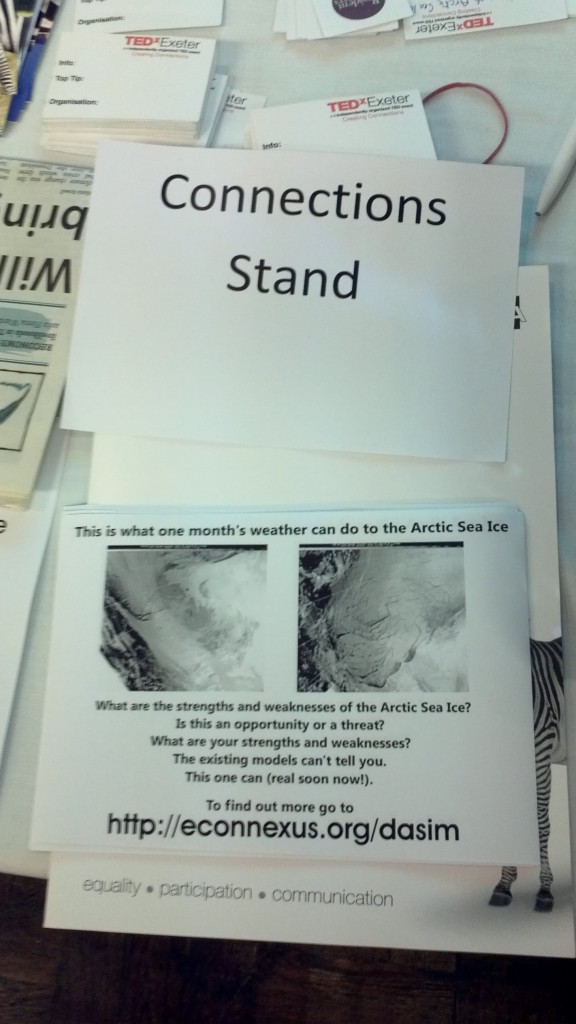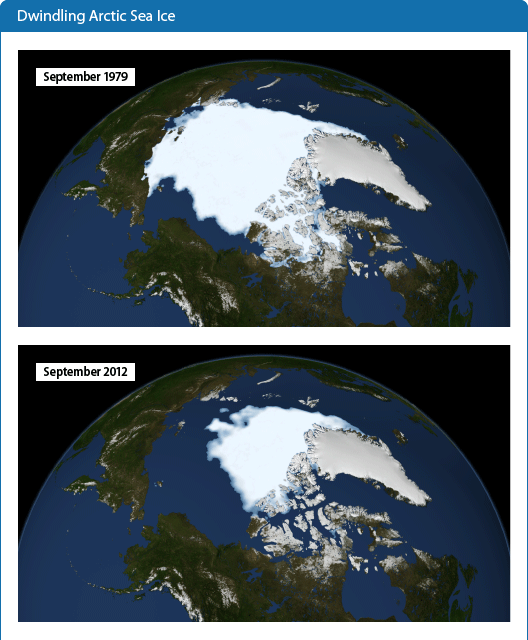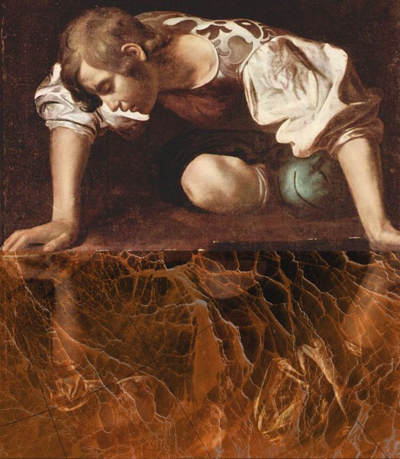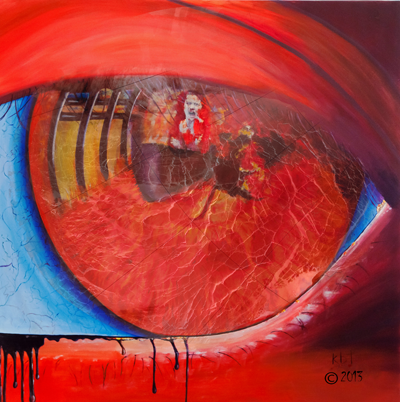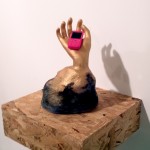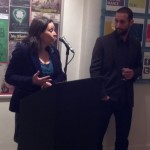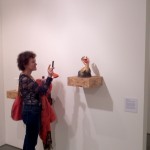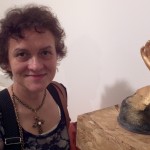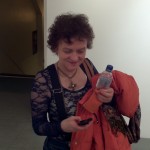Yesterday evening Kasia and I climbed Roughtor on the northern side of Bodmin Moor in North Cornwall to watch the setting sun.
On the way home we were astonished to witness this awe inspiring piece of performance art by a flock of thousands of starlings:
From Cowboys to Astronauts – Art exhibition from waste materials.
“I’ve often heard people say: ‘I wonder what it would feel like to be on board a spaceship,’ and the answer is very simple. What does it feel like? That’s all we have ever experienced. We are all astronauts on a little spaceship called Earth.” – R. Buckminster Fuller
I am taking part in an art exhibition in Exeter, entitled From Cowboys to Astronauts. It is a very special exhibition, because all of the work is made from waste materials.
We, artists from Devon, are presenting objects, installations, visual art etc. made from waste. The meaning of it is to promote the concept of a circular economy – a regenerative economic system where materials and energy from products are recovered and put back into the system instead of simply being disposed of.
The initiative for this exhibition came from the Centre for Alternative Materials and Remanufacturing Technologies (CALMARE), a business technology centre, based at the University of Exeter and part funded by the European Regional Development Fund (ERDF). The waste materials used in the exhibition have been sourced from the University itself, from the private ‘collections’ of artists and from other locations around Devon, including Exeter and Plymouth Scrapstores, Peninsula Waste Savers in Okehampton and the Devon County Council landfill sites managed by SITA.
Artists, as innovators with the ability to look at the materials from a different point of view and see issues with a touch of imagination, have a valuable role to play in turning waste products into objects of value. It could be for exemple an aesthetical, practical or conceptual value. The hope is that this can raise awareness and be an effective education tool for viewing these products in a new way.
On Saturday 2nd May, there was a Family Day and a workshop for kids, where the children got the chance to use recycled materials and produce some very interesting objects. All the work made by the children can be seen at the exhibition space.
The next ‘Meet the Artist day’ will be on Saturday 16th May. It will give the public an opportunity to talk to some of the exhibiting artists and find out more about their work.
Entry to the exhibition is free, and it is open to the public from Monday to Saturday, excluding bank holidays, until the final Friday, May 22nd 2015.
The exhibition takes place in Exeter, at The Enviro Hub, Devon Contract Waste – Marsh Barton Road Exeter, EX2 8NU.
A very unusual place and very unusual exhibition. I hope to see you there.
Much Ado About How To Become A Famous Artist
“Much Ado About How to Become a Famous Artist” is my first animation movie. I wrote the whole script and produced the animation in collaboration with Nikolaus Cieslinski. The movie was made in cooperation with the VisionLore Group. They are a Polish animation company who designed the visual characters.
It is a humorous view of the modern contemporary art scene in the 21st century. It is based on my experiences as a female fine artist, a painter. I still think that mastery, technique and talent are more important than the contemporary concept that “expressing yourself” is all that counts. Everybody can express their own feelings in their own particular way. You don’t have to be a “fine artist”, you don’t have to have any “technique”, following that principle everyone is an artist as long as they “express themselves”. All that is required in this brave new world is a “concept”. But is that ART? I don’t want art to be elitist, but art should be about truth, beauty and the sacred. And yes, there are some objective criteria for these categories!
Here is my own conception of the modern art world, in moving pictures:
Much Ado About How To Become A Famous Artist from Kasia Turajczyk on Vimeo.
Living The Question – “Are You Worried About the Arctic Sea Ice?”
Having bought a pair of tickets to this year’s TEDxExeter the day they went on sale I finally got around to working out what to expect there the day before the event. On opening their web site on April 11th I discovered that the theme for the 2013 event was “Living the Questions“, and the most recent blog post was entitled “If you could ask a stranger any question, what would it be?”, which suggested that:
The English talk about the weather because we find the exchange of personal information too uncomfortable.
which led the TEDxExeter “Storyteller” to ask the question
I wonder whether it would be possible to overcome those inhibitions at TEDxExeter? We could prepare ourselves, have a question ready to ask and be open to the questions others ask in return.
As regular readers of the “Implementing Imagination” blog will know, despite being born and bred in England I have no qualms about approaching total strangers and asking them about contemporary art instead of the weather! I therefore instantly decided to enter into the TED spirit of things. I wandered (virtually) from the TEDxExeter blog over to Twitter in search of some immediate (albeit still virtual) interaction with some English strangers. The #TEDxExeter hashtag revealed the following “tweets” to me:
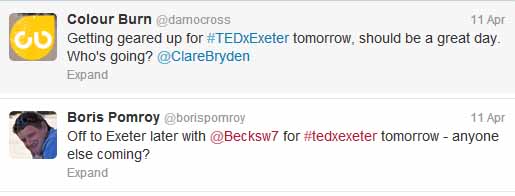 Since Damo and Boris had been kind enough to start the conversation I replied as follows:
Since Damo and Boris had been kind enough to start the conversation I replied as follows:
@damocross @clarebryden @borispomroy Since you ask, I shall be at #TEDxExeter tomorrow. I’m a stranger. What will you ask me?
— Jim Hunt (@jim_hunt) April 11, 2013
Click the date to discover what happened next in the virtual world of the Twittersphere. To cut a long story short, I decided to ask some English strangers the question “Are you worried about the Arctic Sea Ice“, in part because it is in fact related to the English weather, but mainly because it’s a subject I think everybody should be interested in at the very least, although very few people actually seem to be!
In real life the next day Kasia and I arrived at the Northcott Theatre, and I set about asking people my question, along with trying to find the strangers I’d “met” on Twitter the evening before in order to ask them my question face to face. The people we sat down next to were certainly worried about Arctic sea ice.
At the first coffee break I discovered that I still had a few leaflets left in my backpack after a recent trip to Oslo. I took them to the TEDxExeter “Connections Stand”, where Helen assured me that she was worried about the Arctic Sea Ice too:
That being the case, it seemed like a good idea to leave a few of my pieces of paper on the connections table:
After that I also managed to put my question to a couple of the speakers from the first session. Both Peter Owen-Jones and Jonathon Porritt were very worried about the Arctic Sea Ice.
After the next session of presentations we were queuing for lunch when Damo unknowingly came up to me to ask me if I’d like to put my business card in his bucket. I discovered that his company Colour Burn was filming the event, and that he too is very worried about the Arctic sea ice.
Although I didn’t get to ask him my question in person it became obvious after lunch that at least one of the other speakers was very worried about the Arctic sea ice too. Stewart Wallis is Executive Director of the New Economics Foundation, and was the final speaker of the day. He actually showed a slide displaying the rapid decline in Arctic sea ice to the assembled crowd, a bit like this one:
Stewart also showed us all a video of the nef’s Impossible Hamster, as a partial explanation for that decline:
The commentary to the video asks another question, on Stewart’s behalf:
Why do most economists, and politicians, think that the economy can grow for ever, and ever, and ever?
In answer to that question here’s a video from another TED event. This one shows Tim Jackson in 2010 explaining that:
This is a strange rather perverse story. Let me put it this way in very simple terms. It’s a story about us people, being persuaded to spend money we don’t have, on things we don’t need to create impressions that won’t last on people we don’t care about.
By the time Stewart Wallis left the stage at the Northcott I had discovered that Clare was in fact the TEDxExeter Storyteller, and that she was sat with her laptop at the back of the Northcott Theatre. I caught up with her there after the show was over, to discover that whilst she was aware of the declining sea ice in the Arctic, she didn’t seem at first sight to be as worried about it as Damo or Stewart or I.
At the end of the day on April 12th 2013 I never did get to meet Boris in person, but at least we now have a date for TEDxExeter 2014. Perhaps then I’ll be able to ask him this question too:
Are you worried about the Arctic Sea Ice?
TEDxExeter, Rilke, Schumann and Pirates.
A few months ago Jim enlightened me about TED. Since then I have watched every now and then TED talks – videos about our planet, our lives, our future, our possibilities etc. etc. They are stories from “ordinary” people with passions, vocations and courage to be different, to be unconventional.
Yesterday I attended for the first time a TED event. It was close to home, in Exeter, TEDxExeter 2013. It was an unforgettable experience. It began with an inspired fragment from the Letters to a Young Poet by Rainer Maria Rilke. I studied R.M.R. poetry and letters when I was in high school, and I did it thoroughly. As a young girl I was very romantic, and Rainer Maria was very dramatically an exalted and romantic poet. Here is the English translation from the Letters to a Young Poet:
I beg you, to have patience with everything unresolved in your heart and to try to love the questions themselves as if they were locked rooms or books written in a very foreign language. Don’t search for the answers, which could not be given to you now, because you would not be able to live them. And the point is to live everything. Live the questions now. Perhaps then, someday far in the future, you will gradually, without even noticing it, live your way into the answer.
Mad as I am I spent a few hours today reading the letters in the original versions, but I couldn’t find the fragment. Probably the English translation is very licencia poetica. Nevertheless it is wonderful to read Rilke in his own language again.
From the first till the last TED speakers, all of them, were fascinating and inspiring. The day was divided into four sections:
- THE BIG PICTURE
- THE POWER OF CONNECTION
- TRANSFORMATION
- WHAT FUTURE
The speakers were from different backgrounds and different disciplines: scientists, farmers, artists, public services, activists, pirates, entrepreneurs etc.
I was very touched by Jo Berry’s story. I found her story very moving and honest. When her father was killed in the IRA Brighton Bombing during the 1984 Tory Party Conference, Jo was thrown into a conflict she knew very little about. Since then she has visited Ireland many times and worked with victims and former combatants from all sides. In November 2000 she met Pat Magee, the man responsible for her father’s death and after that they created together The Forgiveness Project; and they become good friends.
When listening to her words :
I’m beginning to realise that no matter which side of the conflict you’re on, had we all lived each other’s lives, we could all have done what the other did
I thought to myself, maybe there is some hope for human kind.
I loved the talk by the American violinist Robert Gupta ( video only). He tells a moving story of society’s marginalized and the power of music therapy, which can succeed where conventional medicine fails. He mentioned a beautiful quote from Schumann:
Licht senden in die Tiefe des menschlichen Herzens – des Künstlers Beruf.
the English translation:
To send light into the darkness of men’s hearts – such is the duty of the artist.
Here is one of his videos
One of my favourite talks was unfortunately also only a video, but a very strong one by Allan Savory. His presentation was about how to fight desertification and reverse climate change. When he mentions this
Burning one hectare of grassland gives off more, and more damaging, pollutants than 6,000 cars. And we are burning in Africa, every single year, more than one billion hectares
it forces you to think about us humans.
After Kester Brewin’s speech entitled “Mutiny! What Our Love of Pirates Tells Us About Renewing the Commons” I just got my own dream back again which was to become a pirate. A piglet pirate…..and here I am:
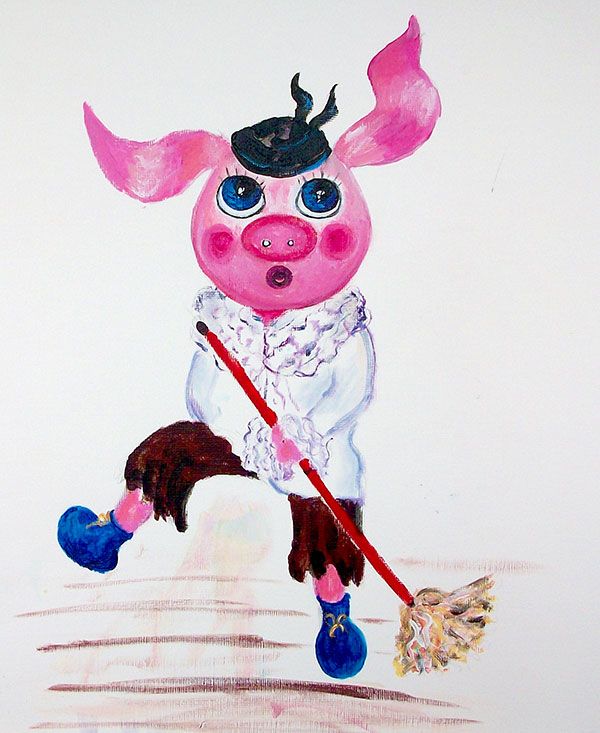
Two times during that day, yesterday, I had this wonderful opportunity to hear poems by Matt Harvey. I loved them. Such brilliant and funny poems; great sense of humour …
Matt Harvey you have got a new fan! Me.
Matt Harvey’s #REMPoem (Squared)
In my professional capacity I attended the renewable energy conference which took place alongside the Renewable Energy Marketplace exhibition organised by Regen SW last month. The venue was the Westpoint exhibition centre just outside Exeter. I was delighted to discover that in between the presentations on how to finance and deliver energy efficiency and renewable energy and the panel debate on how all the theory might actually pan out in practice, space had been made for some performance poetry!
Described in the conference programme as “the enemy of all that’s difficult and upsetting” and “Regen’s poet in residence”, Matt Harvey was a revelation, making us all laugh at his poetic explanation of the thoughts that ran through his mind(s) upon his first ever encounter with a large scale solar PV farm in “The Shock of the New“. Not content with that, Matt went on to invite us all to contribute to a crowd sourced poem about wind turbines! Those of us in the room were invited to write a line of the poem on a strip of blank white paper. Those further afield were invited to contribute a line by “Tweeting” using the #REMPoem hashtag. My own line required no thought at all, since it was already on my own mind before Matt’s invitation, and I believe I was the first to hand in my no longer plain white strip of paper to him. Matt assured me that “partial plagiarism” was perfectly acceptable in all the circumstances.
By mid afternoon Matt had assembled all the contributions (some from as far afield as Canada) into the following performance, hastily recorded on his smartphone by yours truly:
See if you can work out which line was mine? If it’s not immediately obvious to you, here’s a big clue!
I subsequently discovered that another recording had been made of Matt’s performance, so here’s take 2. Amongst other things a not so hasty video recording of me making a hasty video recording of Matt Harvey’s #REMPoem!
Which video do you prefer, and have you worked out by now which line of the poem was mine?
The Mirror Crack’d From Side To Side
Art inspired by the disintegration of the Arctic Ice Cap
Out flew the web and floated wide
The mirror crack’d from side to side;
“The curse is come upon me,” cried
The Lady of Shalott.
Alfred, Lord Tennyson
From “The Lady of Shalott”
The Opening of Neoreplicants at the Exeter Phoenix Gallery
Our report on the opening of the Neoreplicants exhibition which took place on November 16th 2012 at the Exeter Phoenix gallery:
Neoreplicants brings together the results of a partnership between Exeter Phoenix’s annual Digital Art Commission and the University of Exeter’s Centre for Additive Layer Manufacturing (CALM). This opportunity gave thirty South West based visual artists the chance to explore the possibilities offered by the emerging technologies of 3D printing to their art making practice.
Kasia was one of the chosen 30! More words to come in due course, but here are some images of Kasia and her “art making practice”, especially for Shirley :
- Mobile Midas in Reverse
- Sara Flint and Matt Burrows
- Shadows and Light
- KBT + 3D = Alchemy?
- Kasia B. Turajczyk + mobile
Contemporary Art in the Community Unexpectedly Meet Fluxus
Kasia B. T. and I performed together as “Contemporary Art in the Community” at the first “Live Art Meets” event at the Exeter Phoenix art centre two months ago. We put our “performance” together with 1 1/2 days notice and were pleased to receive an enthusiastic response on the night followed by glowing reviews in our guest book.
What with one thing and another we were far too busy to attend the second event last month. A few days ago however, we received the following invitation from Claire Burke via Facebook:
Fluxus was a art movement which started in 50s/60s, pioneered by folks such as John Cage and Yoko Ono
http://www.fluxus.org/ can be used as a resource.
For me Fluxus has been one of the most influential art forms. It is sometimes called an attitude rather than a movement and I feel that this attitude has enriched my every day life and outlook within it.
At Art Meets we’ll be looking at some of the Fluxus scores in the Fluxus workbook and I hope you will join me in interpreting and performing some.
Intrigued, we couldn’t resist the temptation. Having done our bit 8 1/2 weeks ago we left our tripods at home and turned up at the Phoenix shortly before 9 PM last Tuesday, anticipating nothing more than admiring events from the depths of the audience whilst slowly sipping something cool and refreshing. Our most fervent hopes were dashed when with no notice whatsoever Claire coolly informed us that we were expected to pull small pieces of crumpled paper from her Fluxus filled hat and act on the instructions thereon! We fervently gulped from our cold glasses whilst simultaneously girding our loins as Claire kindly played us the following Yoko Ono/Fluxus video to allow us to get our act together:
By this time we had been joined in the “audience” of performers by three other brave souls, and the lottery began. The crumpled pieces of paper that we pulled out of the hat had been chopped out of her Fluxus Performance Workbook by Claire, and these were our instructions:
JLH #1 by Takehisa Kosugi, Micro 1 “Wrap a live microphone with a very large sheet of paper. Make a tight bundle. Keep the microphone alive for another five minutes”.
KBT #1 by Emmett Williams, The Gift of Tongues “Sing meaningfully in a language made up on the spot”.
JLH #2 by Tomas Schmit, Sanitas No.35 “Blank sheets are handed to the audience without any explanation. 5 minutes waiting”.
KBT #2 by Eric Andersen; Opus 46 “This sentence should be not read by more than one person at the same time”
KBT #3 by Larry Miller, Chewed Drawing “Chew a nice piece of notebook or drawing paper”.
More from us on the events of that most enlightening evening in due course. In particular we’re waiting with bated breath to discover what Claire’s video camera managed to record for posterity
SINOPTICON exhibition in Plymouth
A friend of ours is studying art at the Plymouth College of Art. Recently she has been involved in making a film by Erika Tan, “Sensing Obscurity”, which was filmed at the National Trust’s Saltram House near Plymouth. This project is part of the SINOPTICON exhibition, which is in turn part of the “Trust New Art” Programme. The official opening took place yesterday, also at Saltram House. We were invited there to celebrate this event.
The title of the exhibition “Sinopticon” is a compound construction of two words‘ Sino’ meaning China and ‘ optics’, meaning ways of seeing.
Taking chinoiserie as a starting point this exhibition explores the relationship of Western Europe with China both historically and through contemporary eyes.‘Chinoiserie’, a French term meaning ‘Chinese-esque’, derived from the Seventeenth Century as an entirely European style that was influenced wholly from China and the East. The China that was being emulated was in fact fictitious and very few real images of life in China had reached the west. Instead a Utopian land was described and repeated through the use of decorative motifs and styles. The influence and desire for China, it’s trade and culture, ramified in to the 19th century, opium wars, trade and colonialism.
More about the historical background can be found on the Sinopticon website.

